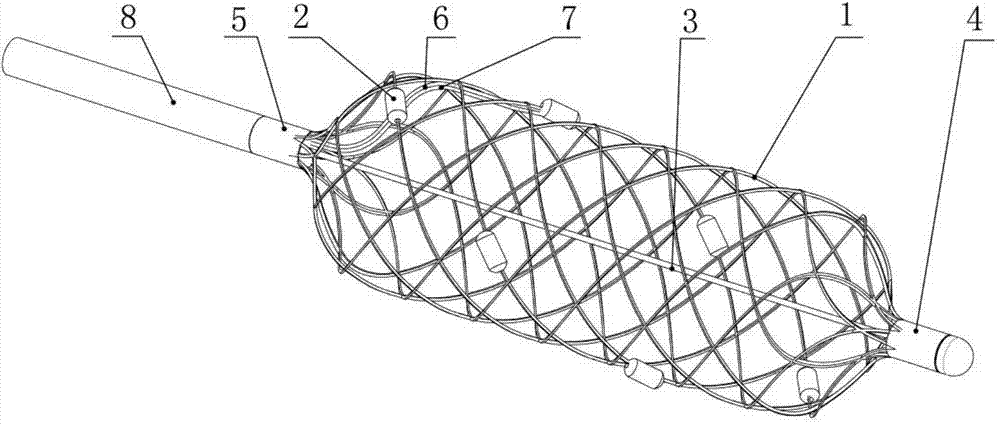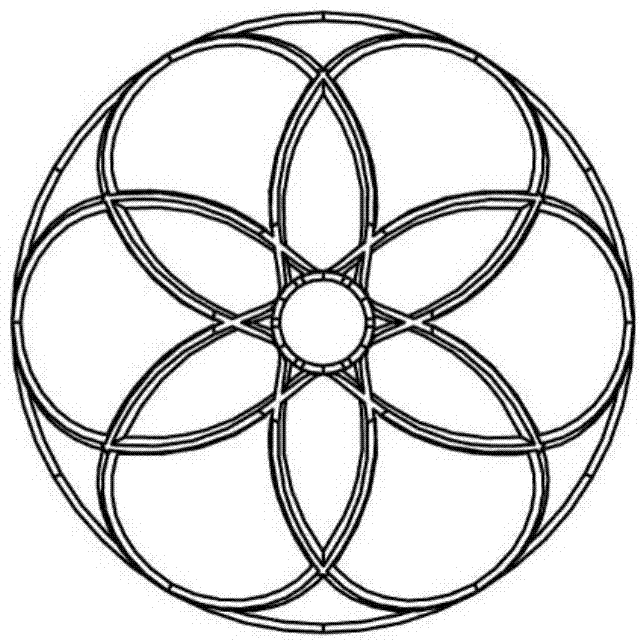Radio frequency ablation catheter with reticulated pipe type support structure and radio frequency ablation device
A technology of radiofrequency ablation and stent structure, applied in the fields of radiofrequency ablation catheters and radiofrequency ablation equipment, can solve problems such as poor adaptability of curved blood vessels, and achieve the effects of good coverage, good coverage and good scalability
- Summary
- Abstract
- Description
- Claims
- Application Information
AI Technical Summary
Problems solved by technology
Method used
Image
Examples
no. 1 example
[0044] Such as Figure 2a and Figure 3a As shown, in the first embodiment, before assembling the mesh tube stent, the mesh tube 1 is first shaped into a central cylinder with both ends contracted (see FIG. 2 ). Specifically, a transition area with a certain inclination angle is provided between the middle cylindrical section (area A) and the contraction sections (ΦB section) at both ends, preferably the inclination angle of the transition area is between 10° and 90° , and, the two ends of the transition region respectively transition with the cylindrical section and the constricted section through circular arcs, and the diameter of the constricted section is equivalent to the diameter of the ablation catheter; The connecting pipe 4 and the second connecting pipe 5 are fixed, so that after assembly, the overall shape of the mesh tubular stent presents a cylindrical shape as shown in 1.
[0045] Figure 2a , Figure 2b , Figure 3a and Figure 3b They are schematic struct...
no. 2 example
[0058] Such as Figure 12 and Figure 13 As shown, the shaped form and assembled form of the mesh tube in this embodiment are different from those of the first embodiment. Before assembling, the mesh tube of the mesh-shaped support is first shaped into a cylindrical shape, and the two ends of the mesh tube are not pre-shrinked, so that when the first connecting tube and the second connecting tube are used to adjust the two ends of the mesh tube After assembly, the overall shape of the tubular stent 10 presents Figure 13 The cylindrical shape shown in the middle protrudes and naturally shrinks at both ends. After the tubular stent 10 expands and adheres to the wall in the blood vessel, multiple electrodes 2 distributed in the middle section of the tubular stent 10 can adhere to the wall at the same time under the action of the vessel wall. Moreover, since the drum-shaped mesh tube is continuously squeezed by the blood vessel wall during the expansion process, the effect of ...
no. 3 example
[0066] In the above-mentioned first embodiment and the second embodiment, the mesh tubes are shaped before being assembled. In the third embodiment provided by the present invention, the mesh tube is not specially shaped before being assembled into a mesh-like bracket. When the radiofrequency ablation catheter protrudes from the sheath, the mesh-shaped stent cannot expand naturally. At this time, by pulling the central wire, it can also ensure that the multiple electrodes set in the middle section adhere to the wall at the same time, and, after the mesh-shaped stent expands and adheres to the wall , the axial projections of the plurality of electrodes do not overlap in the axial direction of the tubular stent, and the circumferential projections of the plurality of electrodes are evenly distributed on the circumferential section of the tubular stent.
[0067] The radio frequency ablation catheter provided by the present invention has been introduced above, and the present inve...
PUM
 Login to View More
Login to View More Abstract
Description
Claims
Application Information
 Login to View More
Login to View More - R&D
- Intellectual Property
- Life Sciences
- Materials
- Tech Scout
- Unparalleled Data Quality
- Higher Quality Content
- 60% Fewer Hallucinations
Browse by: Latest US Patents, China's latest patents, Technical Efficacy Thesaurus, Application Domain, Technology Topic, Popular Technical Reports.
© 2025 PatSnap. All rights reserved.Legal|Privacy policy|Modern Slavery Act Transparency Statement|Sitemap|About US| Contact US: help@patsnap.com



